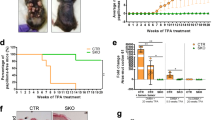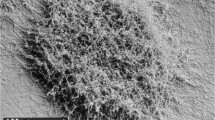Abstract
The possible role of saccharin in the carcinogenic process is, at present, still unclear. Carcinogenesis is a complex process involving, in many test systems, initiation and promotion phases1. Current evidence favours the hypothesis that initiation is due to a mutagenic event, while promotion (at least the early portion) is the result of epigenetic changes2. Although saccharin has been reported to be a weak mutagen in various in vitro test systems and a weak initiator in mouse skin3–7, there is increasing evidence from in vitro, as well as in vivo, studies that it might act as a tumour promoter8–13, rather than as a mutagen14–19. Recently, L.P.Y. et al.20 and J.E.T. et al.21 developed an in vitro assay to detect tumour promoters, which has been independently reported by Murray and Fitzgerald22. The assay is based on the principle that phorbol ester-type tumour promoters block ‘metabolic cooperation’ or a type of cell–cell communication between cells. We report here a series of experiments demonstrating the elimination of metabolic cooperation in the hypoxanthine guanine phosphoribosyltransferase (HGPRT) system in Chinese hamster V79 cells, indicating that saccharin shares properties similar to those of other known promoters.
This is a preview of subscription content, access via your institution
Access options
Subscribe to this journal
Receive 51 print issues and online access
$199.00 per year
only $3.90 per issue
Buy this article
- Purchase on Springer Link
- Instant access to full article PDF
Prices may be subject to local taxes which are calculated during checkout
Similar content being viewed by others
References
Slaga, T. J., Sivak, A. & Boutwell, R. K. Carcinogenesis: Mechanisms of Tumor Promotion and Cocardnogenesis, Vol. 2 (Raven, New York, 1978).
Trosko, J. E. & Chang, C. C. in Chemical Carcinogens and DNA (ed. Grover, P.L.) (CRC Press, Cleveland, 1979).
Batzinger, P. P., Ou, S. L. & Bueding, E. Science 198, 944–946 (1977).
Wolff, S. & Rodin, B. Science 200, 543–545 (1978).
Moore, C. & Schmick, A. Mutat. Res. 67, 215–219 (1979).
Moore, C. & Schmick, A. Science 205, 1007–1010 (1979).
Renner, H. W. Experimentia 35, 1364 (1979).
Reuber, M. D. Environmental Health Perspectives 25, 173–200 (1978).
Boyland, E. Nature 278, 123–124 (1979).
Hicks, R. M., Wakefield, J. St. J. & Chowaniec, J. Nature 243, 347–349 (1973).
Hicks, R. M. & Chowaniec, J. Cancer Res. 37, 2943–2949 (1977).
Mondal, S., Brankow, D. W. & Heidelberger, C. Science 201, 1141–1142 (1978).
Cohen, S. M., Arai, M., Jacobs, J. B. & Friedell, G. H. Cancer Res. 39, 1207–1217 (1979).
Kramer, P. G. N. Mutat. Res. 32, 81–92 (1975).
Lutz, W. K. & Schlatter, C. Chem. biol. Int. 19, 253–257 (1977).
Brogger, A., Ardito, G. & Waksvik, H. Hereditas 91, 135–138 (1979).
Poncelet, F., Roberfroid, M., Mercier, M. & Lederer, J. Fd Cosmet. Tox. 17, 229–232 (1979).
Sweetman, T. W. & Renwick, A. G. Science 205, 1019–1020 (1979).
Leonard, A. & Leonard, R. D. J. envir. path. Tox. 17, 229–232 (1979).
Yotti, L. P., Chang, C. C. & Trosko, J. E. Science 206, 1089–1091 (1979).
Trosko, J. E., Yotti, L. P., Dawson, B. & Chang, C. C. in Short Term Tests for Chemical Carcinogens (ed. Stich, H.) (Springer Berlin, in the press).
Murray, A. W. & Fitzgerald, D. J. Biochem. biophys. Res. Commun. 91, 395–401 (1979).
van Zeeland, A. A., Van Digglin, M. C. E. & Simons, J. W. I. M. Mutat. Res. 14, 355–363 (1972).
Wolff, S. A. Rev. Genet. 11, 183–201 (1977).
Kinsella, A. R. & Radman, M. Proc. natn. Acad. Sci. U.S.A. 75, 6149–6153 (1978).
Author information
Authors and Affiliations
Rights and permissions
About this article
Cite this article
Trosko, J., Dawson, B., Yotti, L. et al. Saccharin may act as a tumour promoter by inhibiting metabolic cooperation between cells. Nature 285, 109–110 (1980). https://doi.org/10.1038/285109a0
Received:
Accepted:
Issue Date:
DOI: https://doi.org/10.1038/285109a0
This article is cited by
-
Cell culture assays for chemicals with tumor-promoting or tumor-inhibiting activity based on the modulation of intercellular communication
Cell Biology and Toxicology (1994)
-
Multistage carcinogenesis: implications for risk estimation
CANCER AND METASTASIS REVIEW (1988)
-
Effects of fatty acids on gap junctional communication: Possible role in tumor promotion by dietary fat
Lipids (1987)
-
Effects of tumor promoters, genotoxic carcinogens and hepatocytotoxins on mouse hepatocyte intercellular communication
Cell Biology and Toxicology (1986)
-
Saccharin induces morphological changes and enhances prolactin production in GH4C1 cells
In Vitro Cellular & Developmental Biology (1985)
Comments
By submitting a comment you agree to abide by our Terms and Community Guidelines. If you find something abusive or that does not comply with our terms or guidelines please flag it as inappropriate.



